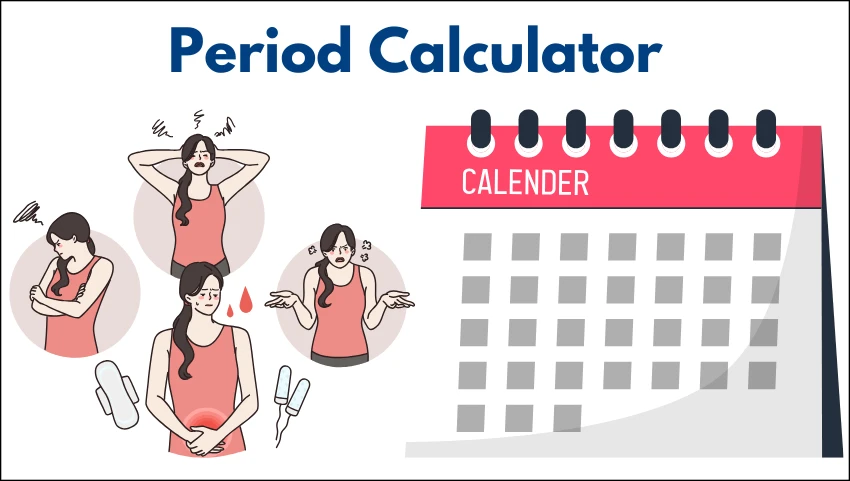Period Calculator
Understanding and tracking your menstrual cycle is an essential aspect of women’s health and wellness. A period calculator is a helpful digital tool designed to make this task easy, accurate, and stress-free. It helps you predict when your next period will start, when you will ovulate, and identify your most fertile days.
What is a Period Calculator?
A period calculator is an online tool or app that estimates the dates of your future menstrual cycles based on your past cycle data. By entering the first day of your last period and your average cycle length, the calculator predicts when your next period is likely to begin. Some calculators also provide details about ovulation and fertile windows, which are useful for family planning and tracking reproductive health.

Why is Tracking Your Period Important?
Tracking your menstrual cycle offers several benefits, including:
- Better Health Awareness: Your menstrual cycle reflects your overall health. Changes in your cycle can signal underlying health conditions like hormonal imbalances, polycystic ovary syndrome (PCOS), or thyroid issues.
- Planning and Preparation: Knowing when your period will arrive helps you plan your schedule and activities without surprises.
- Family Planning: Whether trying to conceive or avoid pregnancy, tracking ovulation and fertile days is crucial.
- Managing Symptoms: Tracking helps anticipate and manage Premenstrual Syndrome (PMS) symptoms such as mood swings, cramps, and fatigue.
How Does a Period Calculator Work?
The period calculator works on a simple mathematical principle:

- You input the first day of your last period.
- You provide your average menstrual cycle length (number of days between the start of one period to the start of the next).
- The calculator adds the cycle length to the last period start date to predict your next period.
- If it includes ovulation, it estimates ovulation as usually occurring around 14 days before your next period.
- The fertile window is typically calculated as a few days before and after ovulation.
The typical menstrual cycle length is about 28 days but can vary between 21 and 35 days per person.
How to Use a Period Calculator Step-by-Step
Here is a simple guide to using a period calculator:
- Find the first day of your last period: This is the day when you started bleeding.
- Know your average cycle length: Count the number of days from the first day of one period to the day before the next period starts. If unclear, use 28 days as an average.
- Enter your period duration: How many days your period lasts.
- Input these details into the period calculator.
- Click “Calculate” to see your upcoming period dates, ovulation, and fertile window.
Understanding Your Period Calculator Results
The results from a period calculator give you:
- Next period start date: When your upcoming period is likely to begin.
- Ovulation day: The day when an egg is released from the ovary, critical for conception.
- Fertile window: Days when you are most likely to conceive if trying to get pregnant.
- Period end date: The date when your period is expected to end based on your average flow duration.
Remember, these predictions are estimates and can vary due to factors such as stress, illness, or lifestyle changes.
Example of Period Calculation
| Last Period Start Date | Cycle Length (days) | Next Period Start Date | Ovulation Day | Fertile Window |
|---|---|---|---|---|
| September 1, 2025 | 28 | September 29, 2025 | September 15, 2025 | September 12 – 17, 2025 |
What Affects Your Menstrual Cycle?
Your menstrual cycle can change due to various reasons, including:
- Stress: High stress levels can delay or disrupt your cycle.
- Weight Changes: Sudden weight gain or loss impacts hormones controlling the cycle.
- Exercise: Extremely intense exercise routines can lead to irregular periods.
- Medical Conditions: PCOS, thyroid disorders, and other hormonal imbalances affect cycles.
- Medications: Birth control pills or other medications can alter menstrual patterns.
Benefits of Using a Period Calculator
Predicts Your Next Period
A period calculator gives you an estimated date, so you can stock up on supplies and plan in advance.
Helps with Fertility Awareness
By estimating ovulation and fertile days, it supports those trying to conceive or avoid pregnancy naturally.
Tracks Irregularities
Regular use can spot irregular cycles early, helping you seek timely medical advice if needed.
Manages PMS and Symptoms
Knowing when PMS may strike allows better planning and symptom management.
Period Calculator for Family Planning
For couples trying to conceive, understanding the fertile window is key. Ovulation typically occurs around 14 days before the next period. The days surrounding ovulation (about five days before and one day after) are when conception chances are highest. Period calculators simplify this by providing a calendar, reducing guesswork.
For couples avoiding pregnancy, period calculators help identify safe days based on your cycle, but natural methods require careful use and understanding.
Using Period Calculators with Irregular Periods
If your periods are irregular (cycles vary widely), predictions may be less accurate. However, regularly logging data helps identify patterns over time and gives useful insights. You may also consult healthcare professionals with better cycle logs.
How to Choose the Right Period Calculator?
When choosing a period calculator:
- Pick one that lets you input average cycle length and period duration.
- Look for added features like ovulation and fertility window prediction.
- Prefer calculators with data privacy and security.
- Mobile apps can be handy for daily logging and reminders.
Some reputable period calculator sources include Flo Health, Vedantu, and Motherhood India, which provide reliable tools online.
Tips for Accurate Tracking
- Always record the first day of bleeding as the start of the cycle.
- Track your cycle for at least 3–6 months to find your average cycle length.
- Use notifications or reminders to log data regularly.
- Combine tracking with symptoms like cervical mucus changes and basal body temperature for deeper insights.
When to Consult a Doctor?
You should consult a healthcare provider if:
- You miss periods for more than three months (unless pregnant).
- Your menstrual flow is very heavy or very light.
- You experience severe pelvic pain or extreme PMS symptoms.
- Your cycles are consistently irregular or very short/long.
Frequently Asked Questions
What is a period calculator?
A period calculator is an online tool that helps predict your next menstrual period based on the first day of your last period and your average cycle length.
How accurate is a period calculator?
It provides an estimate but may not be 100% accurate because menstrual cycles can vary due to stress, illness, or hormonal changes.
Can a period calculator help with pregnancy planning?
Yes, it can predict ovulation and fertile days, which are useful for couples trying to conceive or avoid pregnancy.
What information do I need to use a period calculator?
Usually, you need the first day of your last period and the average length of your menstrual cycle.
What if my periods are irregular?
The calculator’s predictions may be less accurate, but regular tracking can help identify patterns over time.
How does the period calculator predict ovulation?
It estimates ovulation as occurring about 14 days before your next expected period based on your cycle length.
Can stress affect my period cycle predictions?
Yes, stress can delay or disrupt your cycle, affecting the accuracy of predictions.
Conclusion
A period calculator is a simple yet powerful tool to help women understand their menstrual cycles better. It supports planning and promotes awareness about reproductive health by estimating periods, ovulation, and fertile windows.
Using a period calculator regularly empowers you to be proactive about your health, reduce surprises, and prepare better for daily activities, family planning, or medical consultations.
